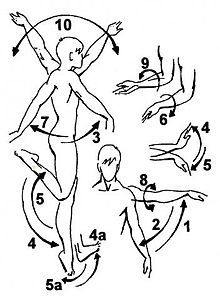Movement (anatomy)
The anatomy differentiates the movements of individual body parts according to their biomechanical possibilities given in the joints . These changes in position and position cannot always be clearly delimited from one another, since movements allow different degrees of freedom of translation and rotation depending on the type of joint and the joints involved . B. also a flexing elbow or knee joint can realize an adduction at the same time .
Spine
- Inclination ( flexion ) - reclination ( extension ): Leaning forward / leaning backward of the upper body / head (see spine )
- Rotation : rotational movement of the upper body / head along the vertical axis
- Lateral flexion : lateral flexion of the upper body
extremities
- Flexion - Extension : Flexion / extension of the hip, spine, elbow and knee joints
- Anteversion - Retroversion : moving an extremity in an anterior / dorsal direction (corresponding to flexion / extension in the shoulder or hip joint)
- Abduction - Adduction : Spreading / bringing a part of the body to / from the vertical axis of the middle of the body / the limbs
- Internal rotation - external rotation: inward / outward rotation in the shoulder and hip joint
- Pronation - supination : inward / outward rotation of the foot and forearm
- Opposition - Reposition : Opposite / set back the thumb to the other fingers
- Inversion - Eversion: lifting the inside / outside of the foot (in the lower ankle )
- Circumduction: Circulating around / circling the limbs in the hip, shoulder, finger and toe joints
- Ulnar (ab) duction - Radial (ab) duction : Spreading the hand / finger in the direction of the ulna ( ulna ) / spoke ( radius )
- Volar flexion / palmar - dorsal extension : flexion / extension of the hand toward the palm / back have
- Plantar flexion - dorsiflexion : flexion / extension of the toes towards the sole / back of the foot
- Plantar extension - dorsiflexion : Extension / flexion of the foot towards the sole / back of the foot
pool
- Pelvic tilt - straightening of the pelvis: flexion (anterior (corresponding to ventral) rotation) / extension (posterior (corresponding to dorsal) rotation) of the pelvis
- Inflare - Outflare: approaching the iliac bones / splaying the seat bones and vice versa
- Nutation - contranutation: tilting movement in the sacroiliac joints , the coccyx moves cranially-dorsally and vice versa
Shoulder girdle
- Elevation - Depression : Raising / lowering the shoulder girdle
- Protraction - retraction: moving the shoulder blade forwards / backwards in an anterior / posterior direction
- External Scapular Rotation - Internal Scapular Rotation: Outward / inward rotation
- Scapular Abduction - Scapular Adduction: Spreading / Bringing In
All movements of the shoulder girdle articulate via the sternoclavicular joint and the ankle joint , see shoulder joint / degrees of freedom
Temporomandibular joint
- In the sagittal plane
- In the horizontal plane
- Protrusion - retraction : lower jaw forward from rest position / back from protrusion position
- Retrusion - Protraction: lower jaw backwards from rest position / back from retrusion position
- Occlusion : Term for the interlocking of the teeth
- Mediotrusion - laterotrusion: lower jaw on one side forward-inward and on the other side backward-outward
- Laterotraction - mediotraction: lower jaw on one side backward-outward and on the other side forward-inward
See also
- Anatomical position and direction designations
- Dislocation (medicine)
- Movement science
- Motor skills
- Musculoskeletal system
literature
- Michael Schünke: Topography and function of the movement system . 2nd Edition. Thieme, Stuttgart / New York 2014, ISBN 978-3-13-118572-3 .
Web links
Commons : Anatomical Movements - Collection of Images
- Movements (English)

